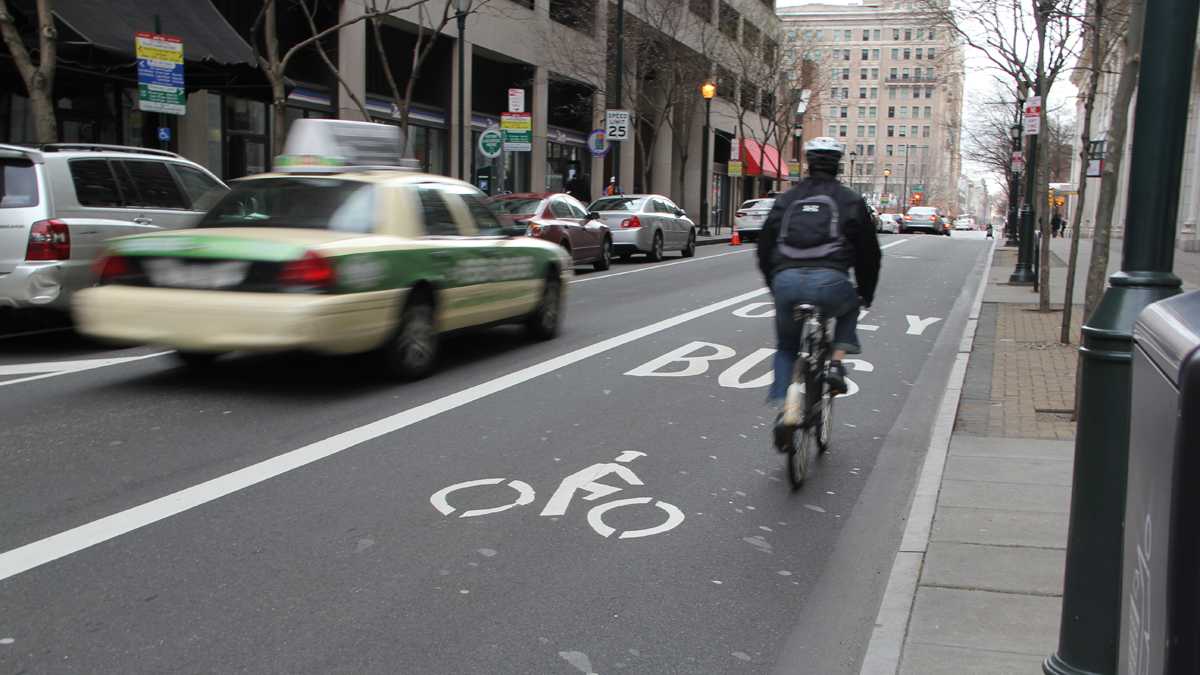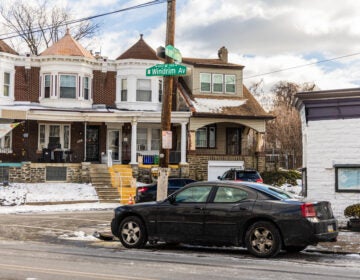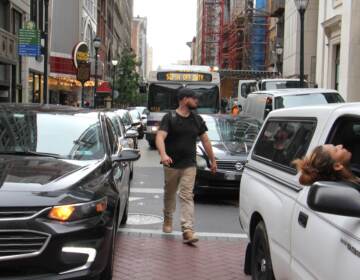Is Philly better off with safer streets or faster moving traffic? At City Hall, it depends on who you ask
“What's the game plan for our vehicular traffic?”
“I’d like to reframe a bit,” Carroll began to respond.
Listen 1:59
A shared lane for bus and bike is shown on Chestnut Street. (Emma Lee/WHYY)
“Could I have the ‘transportation guru’ come up to the table, please?”
That’s how Council President Darrell Clarke called Deputy Managing Director of the Office of Transportation and Infrastructure Systems (OTIS), Mike Carroll, to testify at Tuesday’s Streets Department budget hearing.
If Carroll is the spiritual leader of the city’s newfound religions of Complete Streets — the belief that roads should be built for all users, not just cars — and Vision Zero — a faith that, one day, the city could reduce traffic-related deaths to zero — then Clarke remains an apostate, skeptical of the claim that Philadelphia is ready to convert from an automobile monoculture.
“The city is booming, and vehicular traffic has grown — that’s kind of inconsistent with this thought that new people moving in don’t have cars, and I disagree with that because it’s just not a reality,” Clarke said in a preface of a question. “What’s the game plan for our vehicular traffic?”
“I’d like to reframe a bit,” Carroll began to respond.
Carroll responded by noting that, compared to 2000, congestion in Philadelphia has actually improved, based on traffic counts conducted in Center City and across the region. Clarke disagreed.
“We have a traffic issue in the city and its increasing, and I hear people talking about it all the time, I can’t get around, I can’t get around,” said Clarke. “Is that your thought, that we don’t have an increasing vehicular traffic issue?”
“Reframe,” Clarke interrupted, visibly annoyed, “Meaning: You don’t want to talk about it?”
Tuesday’s hearing pitted OTIS’s focus on street safety against the Council’s traffic congestion concerns. A sense of urgency permeated the conversation, with both sides emboldened by a recent uptick in activity by the city’s transportation planners and traffic engineers after a long period of dormancy.
From 2012, when Councilmember Bill Greenlee passed a bill that mandated Council’s sign-off on nearly all bike lane proposals, until late last year, there hadn’t been a single new bike lane built that replaced an automobile travel lane or a full parking lane. But starting with the construction of a parking-protected bike lane on Chestnut Street in West Philadelphia last fall, and announced plans to implement long-proposed protected lanes on Market Street and JFK Avenue in Center City this spring, OTIS and the Streets Department seem to be pushing ahead despite some lingering doubts among the city’s legislature.
OTIS officials seem to be testing the theory that the city’s adoption of Vision Zero as a policy goal will provide the moral reasoning to push back on congestion complaints as it attempts to redesign the city’s streets with safety, not speed, as the primary concern. As Carroll put it to PlanPhilly in an interview last year, “How many people is the right number to die? Is it okay for one person to die? Is it ok for your son, daughter or wife to be that one person? I don’t think anyone will stand up and say, ‘Yeah, that’s something I’d be okay with if we can get to work faster.’”
At Tuesday’s hearing, Clarke seemed ready to stand up and demand a faster drive to work.
“I know we have an exhaustive study as it relates to bike lanes and bikes and all the things associated with that, but what is the game plan for the vehicular traffic?” Clarke asked Carroll. “I think all of us kind of witness that every morning and in the evening, coming down Broad or whatever.”
Carroll didn’t disagree that some roads in the city are clogged but argued Philadelphia faced more pressing transportation problems, which OTIS hopes to tackle with a forthcoming transportation plan currently under development.
“The idea, though, is mostly focused on safety because the fact is, if you compare the city of Philadelphia to other cities around the country, we’re not really one of the most traffic congested cities around the country. we’re like number 25,” said Carroll, referring to Texas A&M’s Urban Mobility Scorecard’s travel time index. “We are the worst in terms of people getting killed and injured though.”
According to the City’s Vision Zero Action Plan, Philadelphia has the highest per capita traffic death rate among peer cities at six per 100,000.
“So, that’s the priority the administration set, to deal with the people getting killed on the streets,” said Carroll.
“So, it’s not about increased traffic?” Clarke asked in response. “Because you’re talking about everything but what I asked you about.”
Clarke is hardly the only Vision Zero and Complete Streets skeptic on City Council. Councilman Bill Greenlee prefaced his questions over potholes by directing a non-comment at cyclists. “I’ll refrain also from talking about bike lanes,” said Greenlee. “I don’t feel like having my Twitter thing blowing up today.”
Meanwhile, on Twitter, bike-lane supporters following the hearing online were calling for Clarke’s head. Many have grown impatient with what they call the city’s inadequately slow process of improving Philadelphia’s bicycle infrastructure, particularly around protected bike lanes. But as this hearing demonstrated, the faster OTIS tries to move on bike lanes, the fiercer Council’s tongue lashing.
Carroll was later called to the witness table to receive a verbal whipping from CouncilwomanMaria Quiñones-Sánchez over the recently-began construction of bike lanes on North American Street.
Last year, Quiñones-Sánchez held up authorization of the construction of raised bike lanes, which also doubled as a wastewater management project, threatening the loss of federal funds, not only for American Street but also two other, unrelated projects contained in the same grant award. Quiñones-Sánchez was concerned that the project would be a magnet for residential developers, threatening to push out the industrial jobs located along the wide thoroughfare.
“I never want to be in a situation where after we go and request money, I have to figure out on a block-to-block basis: How do I accommodate 63-foot trucks, an industrial zone, curb cuts, bus stops, with bike lanes,” said Quiñones-Sánchez. “We had to sit through numerous, numerous, numerous, numerous, numerous meetings. We have to find a better way. I cannot be told, ‘we have the money, and if we don’t use the money, we’re going to lose it.’”
“As someone who has worked really hard to keep those manufacturing jobs in the area, we have to be more thoughtful around that stuff,” she added, saying that she did not “want to be made the bad guy,” for opposing the mayor’s goal of adding bike lanes “when we don’t think about hundreds of jobs and residents in the area.”
OTIS, the Streets Department, and the general ideas of supporting cyclists and street safety did receive kind words from some of the Council members present, including Helen Gym, Al Taubenberger, and Cindy Bass. Taubenberger referenced the tragic deaths of a family crossing Roosevelt Boulevard, and Gym took the occasion to ask Streets Department officials to keep their plows from dumping snow in the bike lanes during winter storms.
WHYY is your source for fact-based, in-depth journalism and information. As a nonprofit organization, we rely on financial support from readers like you. Please give today.






